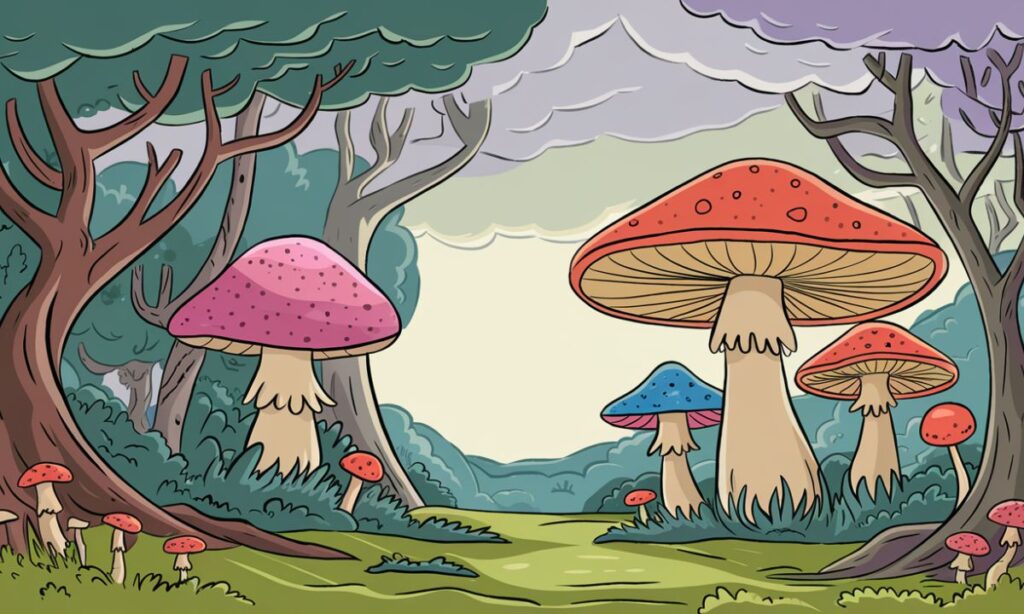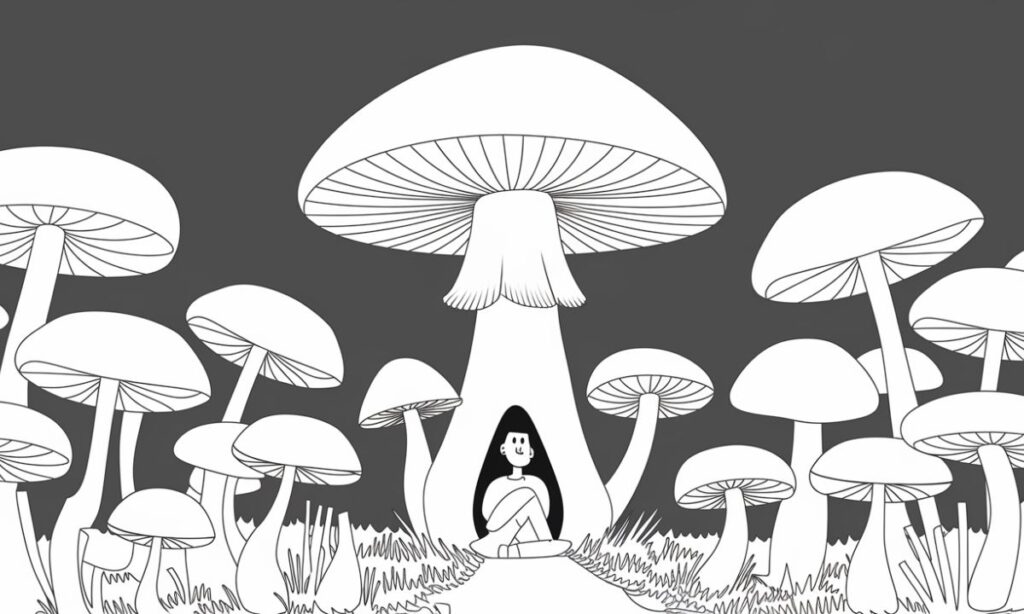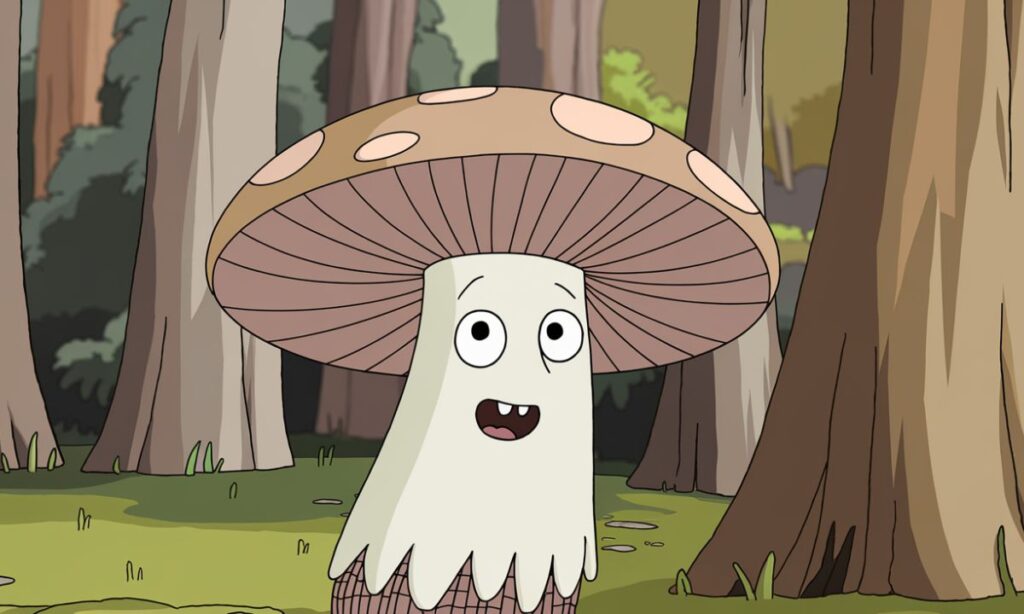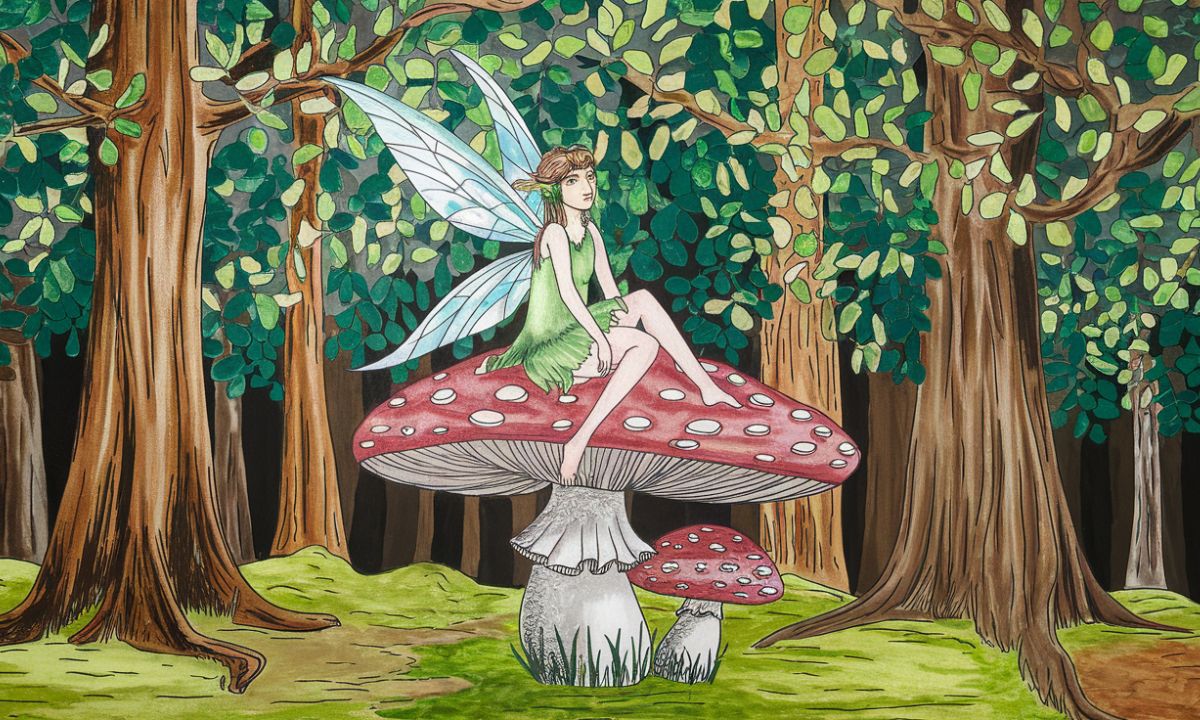Mushrooms have long intrigued artists, with their diverse forms and textures sparking creativity across cultures and generations. From botanical art to abstract and surreal interpretations, mushrooms have an enduring appeal that invites exploration.
In this comprehensive guide, we’ll focus on drawing:places jepq= mushroom, diving into the techniques, tools, and symbolism that make mushroom art such a compelling subject. Whether you’re an experienced artist or a beginner, this in-depth article will give you all the knowledge and inspiration you need to master fungal forms in your artwork.
With tips for mushroom symbolism, environmental art, and mushroom drawing, we aim to create a lasting piece that resonates with the USA audience and ranks high for this keyword.
The Allure of Mushrooms in Art
Mushrooms are naturally mysterious, emerging in hidden places, growing silently in the dark, and often disappearing just as quickly. For artists, this makes them a symbol of nature’s fleeting beauty. Their distinctive shapes and textures make mushrooms a captivating subject in fungal art.
Mushrooms come in an astonishing variety of species, ranging from the familiar button mushrooms to the intricate and delicate structures of the fly agaric or chanterelles. Each type offers its own unique artistic challenges and opportunities.
But it’s not just their appearance that makes mushrooms popular in mushroom art. They also evoke a sense of wonder, closely tied to themes of growth, decay, and transformation. Many artists find the symbolism of mushrooms inspiring, representing the cycle of life, death, and rebirth, as mushrooms often thrive in decaying matter.
This complex mushroom symbolism enriches the appeal of drawing mushrooms, whether through realism or abstract interpretations.
Why Mushrooms are a Perfect Subject for Artists:
- Distinctive forms: From smooth domes to textured stems, each species is unique.
- Versatile in art: Mushrooms can be rendered in various styles, from realism to surrealism.
- Symbolism: Mushrooms carry deep symbolic meanings tied to mystery, growth, and nature.
- Natural diversity: With over 10,000 species worldwide, mushrooms offer endless inspiration.
Historical Significance
Mushroom art is not a modern phenomenon. In fact, mushrooms have appeared in various art forms for centuries. In botanical illustrations, mushrooms were often depicted with meticulous accuracy, showcasing the beauty and intricacies of nature.
Early botanical art focused on cataloging the natural world, which included plants, flowers, and fungi. During the Renaissance and the Enlightenment, mushrooms gained more prominence in scientific illustrations, which doubled as artistic works that displayed exceptional detail and botanical accuracy.
For example, Matsumi Miyazaki, a renowned Japanese botanist and artist, was known for his detailed depictions of fungi, which played an essential role in documenting the biodiversity of Japan. His work combined both scientific detail and artistic flair, influencing generations of artists who sought to capture the complexity of fungal forms.
In Native American art and culture, mushrooms were often linked to the spiritual world. Some tribes believed mushrooms held mystical properties and included them in ceremonial art. In Europe, mushrooms frequently appeared in the background of pastoral scenes and mythological art, hinting at their mysterious and sometimes dangerous nature.
The mushroom’s association with the natural world, spirituality, and the unknown made it a popular symbol in both mushroom symbolism and environmental art throughout history.
The Modern Appeal

In recent years, there’s been a resurgence of interest in mushroom art, driven by a renewed focus on nature and the environment. As people become more aware of the need to protect and preserve biodiversity, environmental art featuring mushrooms has gained traction. Mushrooms, as an integral part of ecosystems, play a vital role in fungal communities and biodiversity, which resonates deeply with artists exploring themes of nature conservation and environmental activism.
For instance, the USA-based environmental artist Jennifer Kenning often incorporates mushrooms into her work, focusing on how these organisms break down organic matter and regenerate life. Her pieces emphasize the critical role mushrooms play in maintaining ecological balance, making her work a powerful statement on sustainability and the interconnectedness of all living things.
Another aspect of modern mushroom art is its place in popular culture. With the rise of platforms like Instagram and TikTok, mushroom-related art has exploded in popularity.
Artists post their mushroom drawings and gain followers from around the world, connecting in mushroom communities and sharing techniques. Additionally, surreal and fantasy art genres often feature fantastical mushrooms, blending reality with imaginative elements.
“Mushrooms are the ultimate symbol of the mystery and resilience of nature. In an age where environmental consciousness is key, they represent the beauty of the unseen and the fragile balance of our ecosystems.” — Jennifer Kenning, Environmental Artist, USA.
The Art of Drawing:places jepq= mushroom: Techniques and Tips
Drawing mushrooms involves a combination of observation, technique, and creativity. Understanding the fundamental techniques of drawing:places jepq= mushroom is essential for capturing the beauty and complexity of these natural forms.
Whether you aim for botanical accuracy or want to explore surreal mushroom art, the process can be deeply rewarding.
Essential Tools for drawing:places jepq= mushroom
Before diving into mushroom drawing, having the right tools at your disposal is crucial. Different tools can create different effects, from sharp, fine lines to soft, blended colors. Here’s a breakdown of the essential tools you’ll need:
| Tool | Description |
| Graphite pencils | Ideal for sketching outlines and adding fine details like gills and delicate textures. |
| Colored pencils | Great for adding layers of color and building texture on the mushroom cap and stem. |
| Watercolors | Perfect for creating soft, subtle gradients and naturalistic tones found in mushrooms. |
| Erasers | Used for refining shapes, removing mistakes, and creating highlights. |
| Blending stumps | Helpful for smoothing pencil shading and creating soft shadows. |
| Ink pens | For bold outlines or creating detailed line work on mushroom surfaces. |
| Digital drawing tools | Apps like Procreate allow for experimenting with various brushes, textures, and layers easily. |
Mastering Fungal Forms: A Step-by-Step Guide
Drawing mushrooms can be broken down into simple steps that make even complex fungal forms approachable. Follow this guide to get started with your mushroom drawing:
- Outline the Cap: Start with a basic dome or umbrella shape. For species like the fly agaric, a rounder cap is ideal, while species like oyster mushrooms have a wider, fan-like cap.
- Draw the Stem: The stem varies in thickness, depending on the species. Make sure the stem supports the cap by giving it enough width and stability.
- Sketch the Gills: Under the mushroom cap, draw fine lines radiating from the center to mimic the gills. These lines should taper toward the edges to create depth.
- Add Texture: Depending on the type of mushroom, add texture to the cap and stem using cross-hatching or stippling techniques. For example, the fly agaric has small white spots on its red cap, while shiitake mushrooms have rough, uneven surfaces.
- Shading and Depth: Use shading to give the mushroom a three-dimensional look. Focus on areas where the cap meets the stem and the underside of the cap to add depth.
- Final Details: Add any final details such as additional gills, spots, or textures. Consider including a background element like grass or moss to situate the mushroom in its natural environment.
By following these steps, you’ll have a realistic and detailed mushroom drawing. Feel free to adjust the steps based on your preferred style, whether you’re going for a botanical accuracy or a more abstract interpretation.
Observation and Sketching

When drawing mushrooms, observation is critical. Take the time to study real mushrooms or high-quality reference images. Pay attention to the small details that make each mushroom unique—whether it’s the smooth curve of a cap, the delicate gills underneath, or the texture of the stem.
Consider visiting natural areas where mushrooms grow, such as forests, gardens, or local parks. Observing mushrooms in their natural habitat will help you develop a deeper understanding of their forms and structure.
For instance, mushrooms that grow in damp, shaded environments often have larger, wider caps to absorb moisture, while those in drier areas might have thicker, rougher stems.
Sketching from life offers a unique opportunity to capture the intricate details of fungal forms. Even quick sketches can help you build muscle memory and enhance your drawing skills over time.
Texture and Details
One of the most exciting aspects of drawing mushrooms is capturing their varied textures. Mushroom artists often use a combination of different techniques to represent the subtle nuances of the mushroom’s surface.
Common Textures in Mushroom Art:
- Smooth caps: Achieve this with light, even strokes using a pencil or colored pencils.
- Bumpy or textured caps: Use stippling or dotting techniques to create a rough surface, as seen in species like the morel.
- Gills: Fine, close lines radiating from the center help to depict the intricate gill structure found under the mushroom cap.
- Stems: Depending on the species, stems can be smooth, fibrous, or bumpy. Cross-hatching or using a combination of shading techniques can help replicate these textures.
Using tools like blending stumps or erasers can also help soften transitions between light and dark areas, especially when shading mushroom caps and stems.
Shading and Depth
Mastering shading is essential for making your mushroom drawing appear three-dimensional. Shading creates depth, making the mushroom look as though it’s popping off the page. Focus on the areas where light would naturally fall and where shadows would be cast, such as under the cap and along the stem.
To create realistic shading:
- Determine the light source: Identify where the light is coming from. This will guide where you place highlights and shadows.
- Shade gradually: Start with light shading and gradually build up darker areas to avoid harsh transitions.
- Use blending tools: Blending stumps or soft tissue can help create smooth transitions between light and dark areas, giving your mushroom a soft, natural appearance.
For more advanced shading, try incorporating cast shadows (shadows the mushroom itself casts on the surrounding area) to ground your drawing and give it a more dynamic composition.
Color and Medium
Mushrooms come in a wide variety of colors, from the bright reds and oranges of the fly agaric to the subtle browns and creams of common edible mushrooms. Selecting the right medium to capture these colors is key to creating a vibrant and realistic mushroom drawing.
Popular Color Mediums for Mushroom Art:
- Watercolor: Ideal for creating soft, translucent layers of color that mimic the subtle shifts in tone found on mushroom caps.
- Colored pencils: Excellent for building up color gradually and adding fine details. Colored pencils are perfect for adding texture to the mushroom’s surface.
- Acrylic or gouache: These opaque paints allow for bold, vibrant colors and can be layered for added texture and depth.
Experimenting with different mediums can open up new possibilities in your fungal art. For example, using a combination of watercolor and ink can create a striking contrast between soft, flowing colors and sharp, detailed line work.
Creative Approaches to Mushroom Art
Beyond realism, mushrooms offer a wealth of creative possibilities. Artists are drawn to mushrooms for their whimsical and surreal qualities, making them perfect subjects for more abstract or imaginative art styles.
Abstract and Surreal Art
If you’re looking to explore a more abstract style, mushrooms provide plenty of inspiration. Their organic, unusual shapes can be exaggerated or simplified to create dynamic compositions. In surreal mushroom art, artists often take liberties with the form, stretching or distorting it to give the mushrooms a dreamlike quality.
“Mushrooms are like nature’s sculptors, and I love to take that idea further in my art by imagining mushrooms growing in impossible places—like floating islands or other planets.” — USA Mushroom Artist, Elise Harper.
Incorporating fantastical mushrooms into surreal landscapes is a popular approach. You might imagine mushrooms growing in unexpected places, such as floating in the sky or sprouting from a character’s body. This blend of reality and fantasy allows for a high level of creativity and innovation in your artwork.
Mixed Media and Digital Art
For artists interested in pushing the boundaries of traditional drawing, experimenting with mixed media or digital tools can lead to exciting results. Combining materials like watercolor, ink, and digital drawing techniques can result in richly layered and visually engaging artwork.
Digital tools like Procreate or Photoshop also offer the flexibility to experiment with different textures, brushes, and effects without the permanence of traditional media. Digital platforms make it easy to try different color schemes or compositions, enabling artists to create polished final pieces.
The Cultural Impact of Mushroom Art

Mushrooms have always had a presence in cultural symbolism and mythology. Their hidden, often ephemeral nature has lent them an air of mystery in many cultures, from European folklore to Indigenous American traditions. Mushrooms were often seen as symbols of the unknown, transformation, or even danger.
In modern times, mushrooms are also deeply connected to environmentalism. Environmental artists frequently use mushrooms to represent the interconnectedness of life and the critical role fungi play in sustaining ecosystems. For example, in mycology art, artists explore the relationship between fungi and their environment, often highlighting the importance of biodiversity and sustainability.
Mushrooms also play a significant role in the growing trend of psychedelic art, inspired by their historical use in spiritual and medicinal practices. In this genre, mushrooms are often depicted in vibrant, swirling colors, representing altered states of consciousness and otherworldly experiences.
Conclusion about: Drawing:places jepq= mushroom
Drawing mushrooms allows artists to tap into both nature’s intricacy and their own imagination. Whether you prefer botanical accuracy, surrealism, or abstract art, mushrooms offer a wealth of creative opportunities. From mastering the technical aspects of shading and texture to exploring symbolic and imaginative interpretations, fungal art opens up endless possibilities.
By applying the right techniques, tools, and artistic approaches, you can create stunning mushroom art that resonates with audiences and ranks well for your SEO goals. With their connection to nature, environmental themes, and timeless beauty, mushrooms are a subject that will continue to inspire artists for generations to come.








